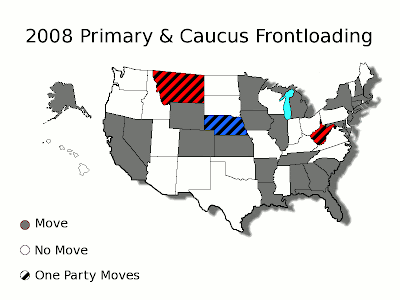I took part in a forum on the [then] upcoming election earlier in the semester and put together some maps on the frontloading that took place prior to primary and caucus season kicking off on January 3. [My, how those ten months flew by!] There is also a map of the differing rules between the parties governing how delegates are allocated. I should have put these up at the time, but I was more concerned with another map at the time.
This first map lays out which states moved and which states stayed put. It needs another layer to it indicating the states that were already early, but that will be a map for a different time. The real message to take away is that there was a ton of movement this cycle compared to some other recent cycles. The striped states are states where just one party opted to move its contest. All were caucus states (at least for the contests moved). The opposite party in each case chose to stick with the state funded primaries, but had later contests as a result.
Now let's look at contest type. First, the Democrats. The darker blue states are primary states while the lighter states are the caucuses. Obviously the number of caucuses is dwindling, but it is interesting to see where they are location-wise. Maine is the only state east of the Mississippi that continues to hold a caucus over a primary. Every other caucus state is in the heartland, from the upper midwest into the southwest. Florida and Michigan take on the stripes for obvious reasons. Both held primaries that were initially not counted in terms of delegate allocation. Texas is different because of its primary-caucus set up on the Democratic side.
And the GOP? Well, the same trends that apply to the Democrats apply here also. Nebraska and New Mexico had Republican primaries and Democratic caucuses while West Virginia held a Republican convention and a Democratic caucus. Washington, like Texas on for the Democrats, has a hybrid primary-caucus system. But instead of playing out over the course of one day, as in Texas, the system stretched out over ten days. The caucus, which determined 51% of the delegates, was held on February 9 while the state's primary followed on February 19 and settled the remaining 49% of the delegates.
Finally, let's dig a little bit deeper into the delegate allocation rules. It is one thing to discuss the type of contest, and while the Democrats mandate a proportional distribution of delegates based on the vote in each state, the GOP leaves it up to the state parties to decide how they will allocate delegates regardless of whether the state has a primary or caucus as its mode of delegate selection. The dark red states below are the ones the McCain campaign targeted -- the winner-take-all states. His wins in most of those winner-take-all states on Super Tuesday (California, New York, New Jersey and Missouri) all but assured the Arizona senator of the GOP nomination. Meanwhile, Mitt Romney seemingly took the Obama caucus strategy route, but without any of the benefits. All those caucus states from the map above are states -- due to that system -- which allocate delegates proportionally. That made it even more difficult for Romney or anyone else to catch McCain in the delegate count. Trading winner-take-all states for proportional ones on the Republican side is not a recipe for success.
But GOP delegate allocation isn't a black and white issue. There were a handful of states that used a combination of proportional and winner-take-all systems to dictate how the delegates were divvied up between the candidates. The most common combination was for delegates to be awarded on both the state and county/congressional district level. Within a county or congressional district delegates were allocated on a winner-take-all basis while the statewide delegates would be determined based on whether the leading candidate exceeded a certain percentage threshold -- usually 50%. If that bar was cleared the candidate got all the statewide delegates and if not, they were allocated proportionally.
Let me close by addressing 2012 frontloading briefly. Unless President Obama completely tanks, the Democratic nomination will be uncontested four years from now. With just one contested nomination -- on the Republican side -- the amount of frontloading should diminish. We would expect this regardless of the number of nominations at stake simply because over half the country is already "early". If nothing is done to reform the system in the interim, though, there could be rogue states like Florida and Michigan but we would expect tat they would be predominantly Republican states since that party's nomination is the one at stake.
As I get more into dissertation writing mode over the next few months, there will likely be follow ups here (with maps of course.).
Recent Posts:
What About Nebraska's 2nd District?
The Georgia Senate Runoff
Obama is the Unofficial Winner of North Carolina





No comments:
Post a Comment